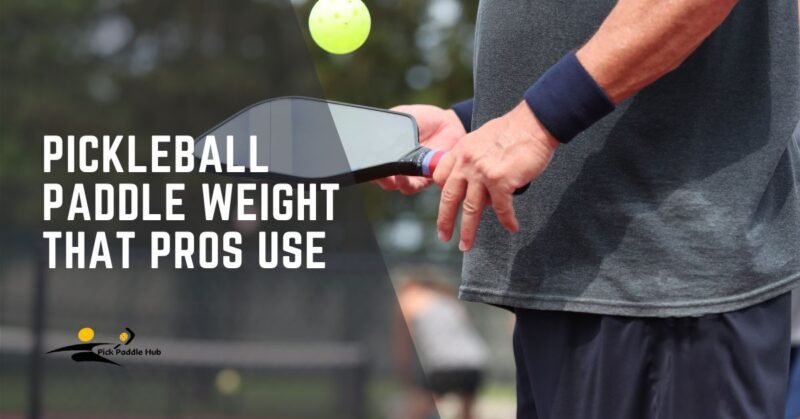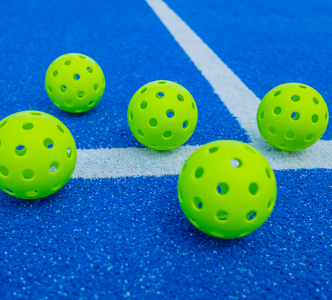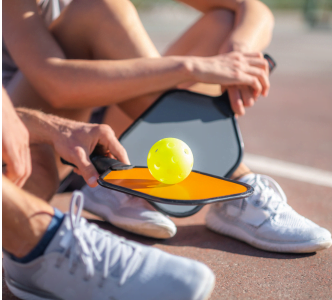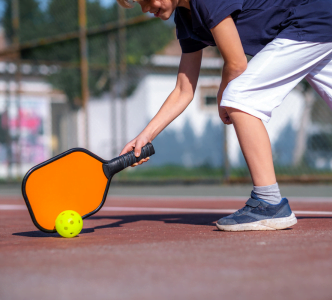Welcome to the world of pickleball, a sport where the paddle you choose can make a significant difference in your game, especially at the professional level. If you’re just starting, understanding what pickleball paddles the pros use can be incredibly insightful.
The right paddle isn’t just about having a fancy tool in your hand; it’s about enhancing your performance, ensuring the best weight for your playing style, and matching the fitness level required for competitive play.
In this guide, we’ll dive into why selecting the appropriate paddle matters and how it can impact your game. Whether you’re curious about the weight of pickleball paddles or simply looking for practical advice on choosing the right one, you’re in the right place. Let’s explore together how to elevate your game by learning from the pros.
What Pickleball Paddles The Do Pros Use?
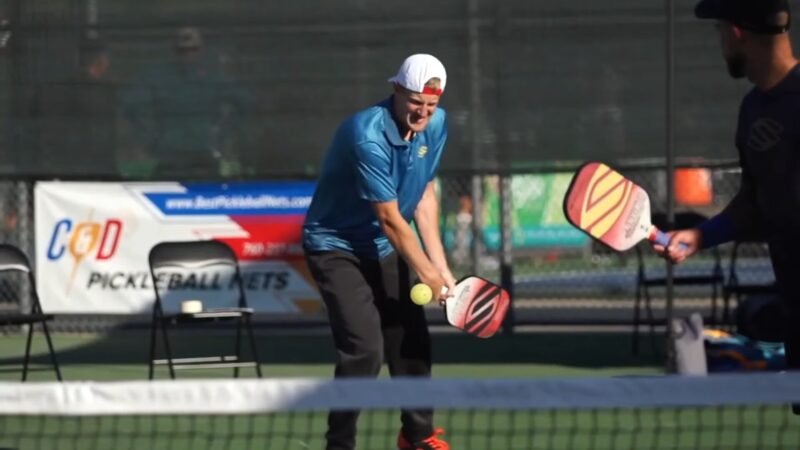
Here are the paddles that the pros use with names:
- Ben Jhons uses, JOOLA Hyperion CFS 16mm signature paddle
- Anna Leigh Water uses, a Paddletek Bantam ALW-C paddle
- Lucy Kovalova uses, Onix Evoke Premier Heavyweight paddle
- Matt Wright uses, Onix Evoke Premier Heavyweight paddle
- Jessie Irvine uses, Engage Pursuit MX Middleweight paddle
- Catherine Pareteau uses, Selkirk Vanguard Power Air Invikta paddle
- Colin Jhons uses, JOOLA Collin Johns Scorpeus 16mm Middleweight Carbon Fiber Paddle
- Parris Todd uses, the signature Selkirk SLK Parris Todd Halo Control XL paddle
- Julian Arnold uses, Volair MACH 1 14mm Middleweight Carbon Fiber Paddle
- Zone Navratil use, ProXR Zane Navratil Middleweight Carbon Fiber Paddle
Ben Jhons
Ben Johns is a dominant force in professional pickleball, renowned for his strategic play and powerful shots. A young prodigy, he’s made waves by partnering with JOOLA, creating the Hyperion CFS 16mm signature paddle, and showcasing his influence on and off the court.
Anna Leigh Waters
Anna Leigh Waters, a rising star in pickleball, has quickly become a household name. Known for her dynamic play and strategic prowess, she dominates the court with her Paddletek Bantam ALW-C paddle, a testament to her skill and dedication to the sport.
Lucy Kovalova
Lucy Kovalova, a top pickleball player, excels in mixed doubles alongside Matt Wright. Known for her precision and power, she wields the Onix Evoke Premier Heavyweight paddle, showcasing her exceptional skill and competitive spirit on the court.
Matt Wright
Matt Wright, a premier pickleball player, shines in mixed doubles with Lucy Kovalova. His choice of the Onix Evoke Premier Heavyweight paddle complements his aggressive playstyle, making him a formidable opponent and a respected figure in the pickleball community.
Jessie Irvine
Jessie Irvine stands out in the pickleball world for her competitive edge and tactical gameplay. Battling to the top with the Engage Pursuit MX Middleweight paddle, Irvine’s blend of power and control makes her a prominent figure on the professional circuit.
Catherine Parenteau
Catherine Parenteau is a consistent top performer in professional pickleball, known for her strategic gameplay and versatility on the court. She wields the Selkirk Vanguard Power Air Invikta, a paddle that enhances her powerful shots while providing exceptional touch and control.
Colin Johns
Colin Johns, brother to Ben Johns, excels in professional pickleball, showcasing his skills on the biggest stages. With the JOOLA Collin Johns Scorpeus 16mm Middleweight Carbon Fiber Paddle, he brings a unique blend of power and finesse to the game, making him a formidable doubles partner and competitor.
Parris Todd
Parris Todd, transitioning from tennis prodigy to pickleball pro, has quickly risen to prominence with her aggressive play and strategic acumen. Her signature Selkirk SLK Parris Todd Halo Control XL paddle reflects her dynamic style, blending power with precision to dominate the courts.
Julian Arnold
Julian Arnold, a passionate player with a tennis background, has made a swift and impactful transition to pickleball. Known for his fiery competitiveness, Arnold uses the Volair MACH 1 14mm Middleweight Carbon Fiber Paddle, a choice that underscores his balance of power and control on the court.
Zane Navratil
Zane Navratil, a pickleball clinician and pro player, is celebrated for his methodical yet engaging teaching style and competitive gameplay. He uses the ProXR Zane Navratil Middleweight Carbon Fiber Paddle, designed for enhanced control and power, making him a formidable opponent in any match.
Why Pro Pickleball Players Preferred These Paddles?
Let’s take a closer look at some of the top professional pickleball players and the paddles they use by, shedding light on how these tools complement their game.
| Player Name | Paddle Quality Emphasis | Description |
|---|---|---|
| Ben Johns | Control and Power | Prefers a paddle designed for precision and heavy-hitting, reflecting his aggressive playstyle. |
| Anna Leigh Waters | Lightweight and Responsive Touch | Uses a paddle that enhances her dynamic and versatile game, allowing for quick volleys and powerful smashes. |
| Lucy Kovalova | Excellent Touch and Control | Chooses a paddle that supports her balanced playstyle, enabling precise shot placement and defensive strength. |
| Matt Wright | Extra Reach and Power | Selects a paddle that complements his aggressive net play, crucial for volleys and overheads. |
| Jessie Irvine | Control and Stability | Focuses on a paddle that aids in strategic placement and finesse shots to outmaneuver opponents. |
| Catherine Parenteau | Great Blend of Power and Touch | Prefers a paddle that offers versatility for driving hard from the baseline or finessing at the net. |
| Colin Johns | Control and Power | Emphasizes a paddle that optimizes defensive play and powerful strokes. |
| Parris Todd | Speed and Power | Chooses a paddle that enhances aggressive play, allowing for fast-paced play and powerful drives. |
| Julian Arnold | Lightweight and Quick Response | Opt for a paddle designed for speed and agility, enabling swift movement and effective strikes. |
| Zane Navratil | Spin and Control | Selects a paddle that prioritizes spin-heavy shots and unique serving techniques to outsmart opponents. |
Key Features of Pickleball Paddles The Pros Use
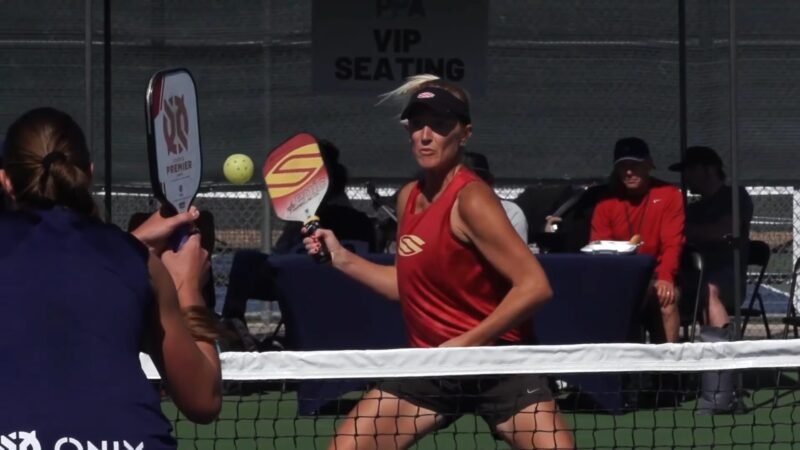
Paddle Shape
The shape of a paddle significantly affects its reach and sweet spot. Professionals often prefer paddles with a longer shape for extended reach, especially useful for volleys and serves. This elongated shape can also provide a larger sweet spot, crucial for precision hits.
Material
The paddle’s material is paramount in determining its responsiveness and durability. Carbon fiber and graphite are popular among pros for their lightweight and sturdy characteristics. These materials offer excellent power without sacrificing control, allowing for swift, powerful shots with great feel and touch.
Grip Thickness
The grip’s thickness can impact a player’s comfort and control over the paddle. Pros select a grip thickness that complements their hand size, ensuring a secure and comfortable hold. They also add an overgrip to the pickleball paddle for better comfort and to reduce slipping. This customization aids in reducing fatigue and increasing accuracy during extended play.
Weight
The weight of the paddle is a critical factor in a player’s performance. A heavier paddle can provide more power, suitable for players with a strong, aggressive approach. Conversely, a lighter paddle offers better speed and manoeuvrability, favoured by players who value quick reactions and finesse. The best weight for a pickleball paddle varies, but professionals choose based on their physical strength and playing style.
Pickleball Paddle Weight for Fitness
Selecting the ideal weight for a pickleball paddle is not only a matter of enhancing game performance but also a key factor in promoting player fitness and preventing injury. A paddle that’s appropriately weighted for an individual’s physical condition and play style can significantly reduce the risk of strain on the arm, wrist, and shoulder muscles.
For fitness-conscious players, a paddle in the optimal weight range—usually between 7.6 and 8.4 ounces—offers the perfect balance between ease of movement and the ability to deliver powerful, controlled shots. This balance ensures that players can enjoy longer, more effective playing sessions without undue fatigue or risk of injury.
Moreover, working with a paddle of the right weight can help improve a player’s endurance and strength over time, as it allows for a natural, efficient swing motion. In essence, the weight of your pickleball paddle is a critical component not just in how well you play the game, but in how the game plays into your overall fitness and health strategy.
How Professional Paddles Enhance Performance?
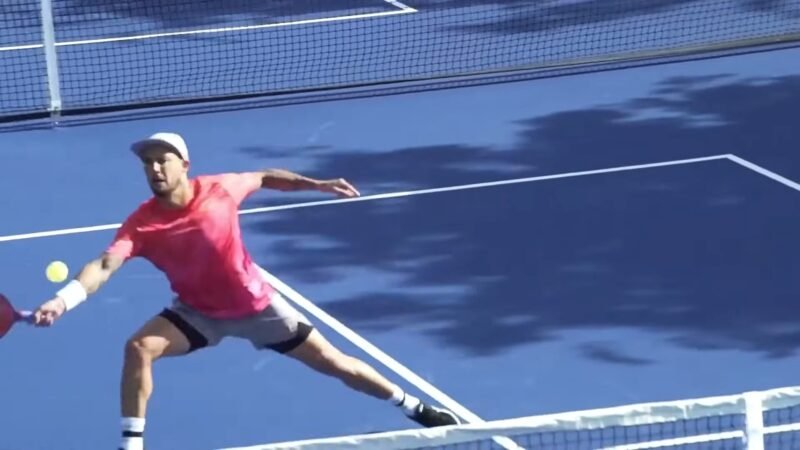
The choice of paddle in pickleball can profoundly affect a player’s performance, influencing everything from the power behind a shot to the finesse of a gentle lob. Professional paddles, with their advanced design and materials, offer enhancements that can significantly elevate a player’s game.
One of the key areas where these paddles make a difference is in the ability to impart spin. The surface texture and material of pro paddles allow for a better grip on the ball, enabling players to execute shots with high levels of spin. This spin can make the ball’s trajectory unpredictable to opponents, providing a tactical advantage.
Power is another critical aspect influenced by the choice of paddle. The combination of paddle weight, material, and design can amplify the force transmitted to the ball, allowing players to hit harder without extra physical effort. This means players can generate deep shots from the baseline or execute powerful smashes with less risk of injury, thanks to the efficient energy transfer offered by these paddles.
Touch and feel are equally vital, especially in a game where precision can be as important as power. Professional paddles often feature materials that provide a responsive feedback loop to the player, enhancing the sense of control over the ball’s placement and speed. This sensitivity allows for adjustments in real-time, fine-tuning shots for optimal placement. Whether it’s dropping a ball just over the net or angling a shot away from an opponent, the right paddle can make these nuanced plays more intuitive.
Furthermore, the ergonomics of professional paddles, including grip size and shape, contribute to a player’s ability to maintain control and precision over long matches. A well-chosen paddle feels like an extension of the arm, reducing strain and fatigue, which in turn preserves the player’s touch and feel throughout the game.
What Weight Pickleball Paddles the Pros Use?
Determining the best weight for a pickleball paddle is crucial for competitive players aiming to optimize their performance on the court. Most professional pickleball players gravitate towards paddles that weigh between 7.6 and 8.4 ounces. This weight range strikes a perfect balance, offering the power, control, and stability that is essential for high-level play.
The choice of a heavier paddle within this range allows professionals to execute shots with more authority and precision. The added mass provides a significant advantage when applying topspin to the ball, enabling the paddle to engage more effectively with the ball’s surface and impart the desired spin. This is particularly useful in adding depth to baseline shots or when attempting to outmanoeuvre an opponent with a well-placed spin shot.
Moreover, the best weight of pickleball paddles ensures that players can punch volleys with enhanced control. In fast-paced exchanges at the net, a paddle with sufficient heft can offer the stability needed to return shots with accuracy, without the paddle twisting in hand. This stability is crucial during high-velocity impacts, common in competitive tournaments and matches, where every shot counts.
Additionally, a paddle within this optimal weight range can absorb shock more efficiently, reducing the risk of arm fatigue and allowing players to maintain a high level of play for longer periods. This aspect is especially important in tournaments where endurance can be as decisive as skill.
The Benefits of Heavier Pickleball Paddles
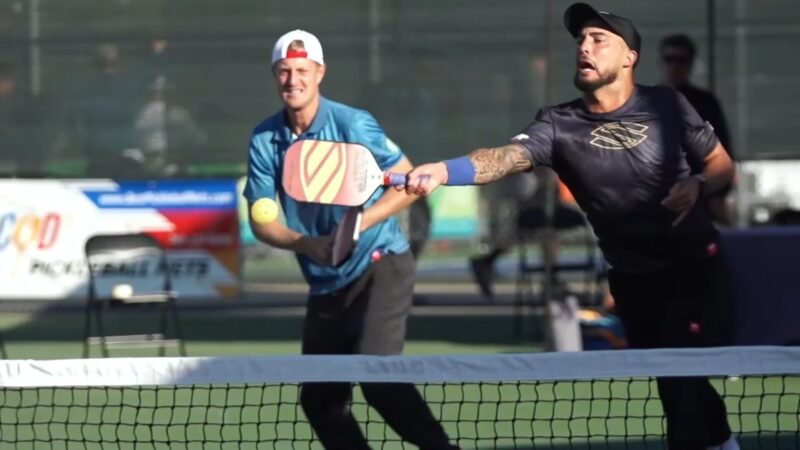
First, let’s discuss why pro players tend to use paddles on the heavier side of the spectrum. Heavier pickleball paddles between 7.6 and 8.4 ounces offer several advantages:
- The weight behind the paddle face lets you swing aggressively and hit with authority. Heavy paddles drive the ball with force so you can hit deep, penetrating shots.
- Heavier paddles provide more torque at the edges to impart heavy topspin or backspin on the ball, allowing greater control of ball flight and bounce.
- The weight makes the paddle face very stable on contact, preventing twisting or control loss, even on powerful hits.
- More mass seems to “hold” the ball briefly, providing great finesse on delicate touch shots like dinks.
- You can feel the ball solidly through a heavier paddle, enhancing your ability to control shot placement and aim precisely.
What Pickleball Paddle Weight Should You Use?
While professional players benefit from the heavier weight of pickleball paddles, how do you know what’s right for your skill level and playing style? Here are some tips:
- Beginners should start around 7.0-7.6 oz to develop proper technique without getting fatigued.
- Intermediate players can move to 7.6-8 oz as skills improve and they want more power and stability.
- Advanced and power hitters can use pro weights of 8 oz plus for maximum pop and control.
No matter your skill, demo various paddle weights when possible to get a personalized feel. And consider these factors:
- Arm strength – Stronger players handle heavier paddles more easily.
- Quick reflexes – Faster players may want lighter paddles around 7.4-7.6 oz.
- Playing style – Defensive players benefit from lighter paddles for quick exchanges.
- Preference – Demo different weights to find your ideal power and comfort zone.
The right pickleball paddle weight is unique for each person. While most pros gravitate to 8+ ounces, choose what provides confidence and effectiveness for your skill level.
Conclusion
In the realm of pickleball, understanding what paddles the pros use offers invaluable insights for players at all levels, especially beginners. The journey to enhancing your game begins with selecting the right equipment—considering factors such as paddle shape, material, grip thickness, and weight, just as professionals do.
Each of these aspects contributes significantly to a player’s performance on the court, affecting everything from power and speed to control and precision. By taking cues from top players and their preferred paddles, you’re not just choosing a tool, you’re equipping yourself with a companion that complements your playstyle and ambitions in pickleball. Whether you’re aiming for power, finesse, or a balance of both, remember that the right pickleball paddle can elevate your game, just as it does for the pros.
FAQ’s
What type of paddle do professional pickleball players prefer?
Professional pickleball players prefer paddles that complement their playing style, focusing on features like material (carbon fiber or graphite for lightweight and strength), paddle shape (for reach and sweet spot size), grip thickness (for comfort and control), and weight (for power and manoeuvrability). Each player may choose differently based on their strategy and physical preferences.
How does the weight of a pickleball paddle affect gameplay?
The weight of a pickleball paddle significantly impacts gameplay. A heavier paddle provides more power, making it easier to drive the ball across the court, while a lighter paddle offers greater speed and manoeuvrability, allowing for quick volleys and defensive plays. Players select their paddle’s weight based on their physical capability and game strategy.
Why is grip thickness important in choosing a pickleball paddle?
Grip thickness is crucial because it affects the player’s comfort and control over the paddle. A grip that matches the player’s hand size ensures a secure hold, reducing the risk of slippage and fatigue during play. This comfort level allows for more precise and controlled shots.
Can the material of a pickleball paddle make a difference in performance?
Yes, the material of a pickleball paddle plays a vital role in performance. Materials like graphite and carbon fiber are favored for their balance of lightweight and strength, offering players a responsive feel for precision shots without sacrificing power. The right material can enhance a player’s ability to execute their game plan effectively.
How do I choose a pickleball paddle like the pros?
To choose a pickleball paddle like the pros, consider your playing style and physical preferences first. Look at the features that professional players prioritize—paddle shape, material, grip thickness, and weight—and how those features align with your needs. Testing different paddles and researching what top players use can also provide valuable insights into making the best choice for your game.

